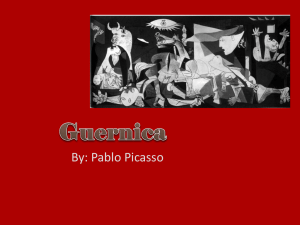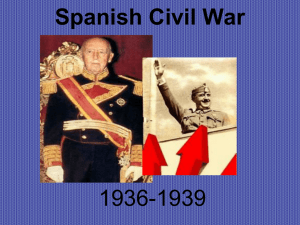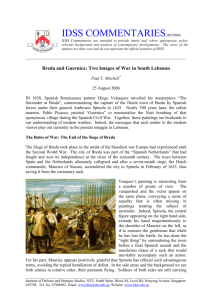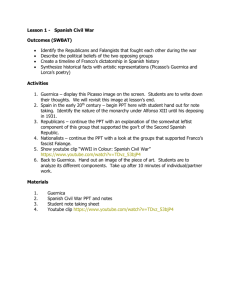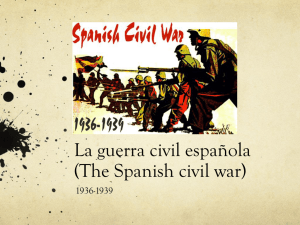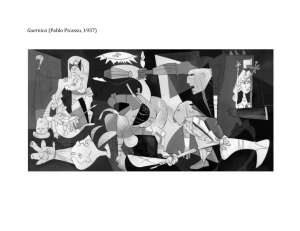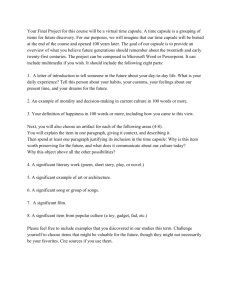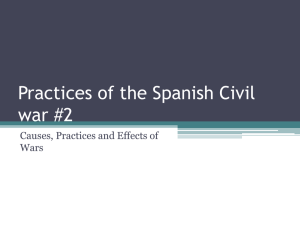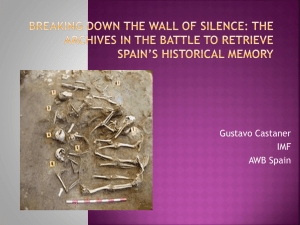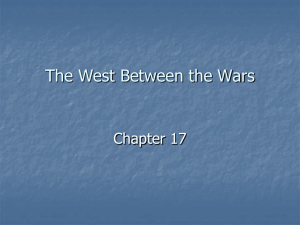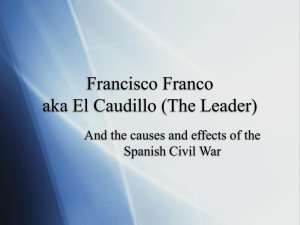background info on civil war - Fort Thomas Independent Schools
advertisement
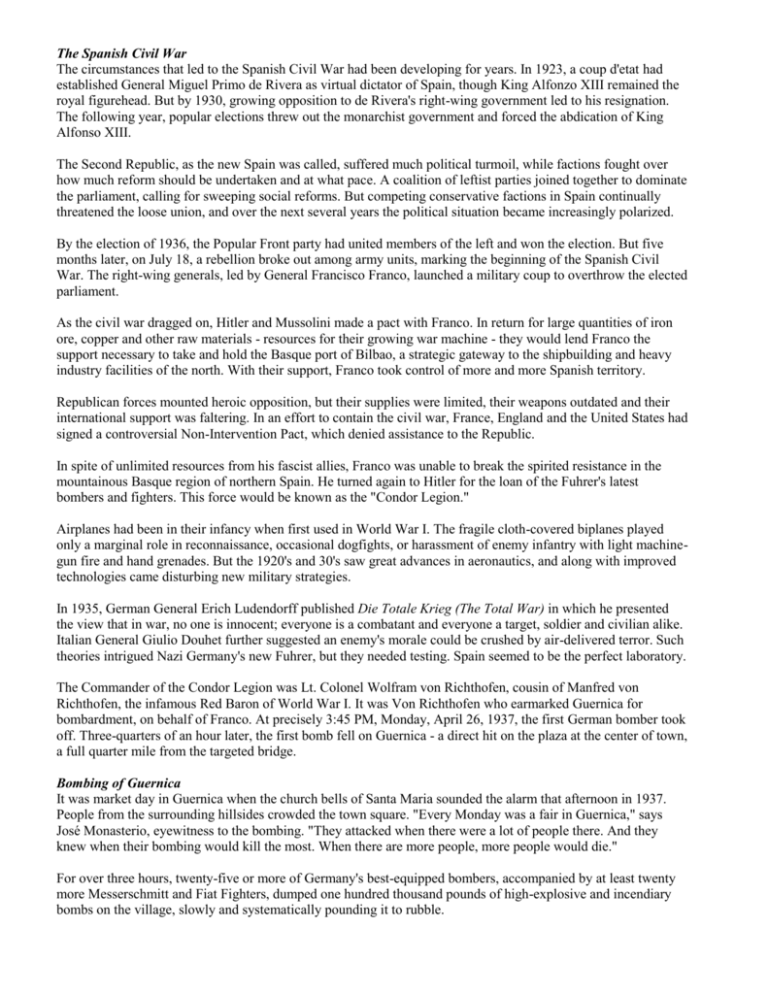
The Spanish Civil War The circumstances that led to the Spanish Civil War had been developing for years. In 1923, a coup d'etat had established General Miguel Primo de Rivera as virtual dictator of Spain, though King Alfonzo XIII remained the royal figurehead. But by 1930, growing opposition to de Rivera's right-wing government led to his resignation. The following year, popular elections threw out the monarchist government and forced the abdication of King Alfonso XIII. The Second Republic, as the new Spain was called, suffered much political turmoil, while factions fought over how much reform should be undertaken and at what pace. A coalition of leftist parties joined together to dominate the parliament, calling for sweeping social reforms. But competing conservative factions in Spain continually threatened the loose union, and over the next several years the political situation became increasingly polarized. By the election of 1936, the Popular Front party had united members of the left and won the election. But five months later, on July 18, a rebellion broke out among army units, marking the beginning of the Spanish Civil War. The right-wing generals, led by General Francisco Franco, launched a military coup to overthrow the elected parliament. As the civil war dragged on, Hitler and Mussolini made a pact with Franco. In return for large quantities of iron ore, copper and other raw materials - resources for their growing war machine - they would lend Franco the support necessary to take and hold the Basque port of Bilbao, a strategic gateway to the shipbuilding and heavy industry facilities of the north. With their support, Franco took control of more and more Spanish territory. Republican forces mounted heroic opposition, but their supplies were limited, their weapons outdated and their international support was faltering. In an effort to contain the civil war, France, England and the United States had signed a controversial Non-Intervention Pact, which denied assistance to the Republic. In spite of unlimited resources from his fascist allies, Franco was unable to break the spirited resistance in the mountainous Basque region of northern Spain. He turned again to Hitler for the loan of the Fuhrer's latest bombers and fighters. This force would be known as the "Condor Legion." Airplanes had been in their infancy when first used in World War I. The fragile cloth-covered biplanes played only a marginal role in reconnaissance, occasional dogfights, or harassment of enemy infantry with light machinegun fire and hand grenades. But the 1920's and 30's saw great advances in aeronautics, and along with improved technologies came disturbing new military strategies. In 1935, German General Erich Ludendorff published Die Totale Krieg (The Total War) in which he presented the view that in war, no one is innocent; everyone is a combatant and everyone a target, soldier and civilian alike. Italian General Giulio Douhet further suggested an enemy's morale could be crushed by air-delivered terror. Such theories intrigued Nazi Germany's new Fuhrer, but they needed testing. Spain seemed to be the perfect laboratory. The Commander of the Condor Legion was Lt. Colonel Wolfram von Richthofen, cousin of Manfred von Richthofen, the infamous Red Baron of World War I. It was Von Richthofen who earmarked Guernica for bombardment, on behalf of Franco. At precisely 3:45 PM, Monday, April 26, 1937, the first German bomber took off. Three-quarters of an hour later, the first bomb fell on Guernica - a direct hit on the plaza at the center of town, a full quarter mile from the targeted bridge. Bombing of Guernica It was market day in Guernica when the church bells of Santa Maria sounded the alarm that afternoon in 1937. People from the surrounding hillsides crowded the town square. "Every Monday was a fair in Guernica," says José Monasterio, eyewitness to the bombing. "They attacked when there were a lot of people there. And they knew when their bombing would kill the most. When there are more people, more people would die." For over three hours, twenty-five or more of Germany's best-equipped bombers, accompanied by at least twenty more Messerschmitt and Fiat Fighters, dumped one hundred thousand pounds of high-explosive and incendiary bombs on the village, slowly and systematically pounding it to rubble. "We were hiding in the shelters and praying. I only thought of running away, I was so scared. I didn't think about my parents, mother, house, nothing. Just escape. Because during those three and one half hours, I thought I was going to die." (eye witness Luis Aurtenetxea) Those trying to escape were cut down by the strafing machine guns of fighter planes. "They kept just going back and forth, sometimes in a long line, sometimes in close formation. It was as if they were practicing new moves. They must have fired thousands of bullets." (eye witness Juan Guezureya) The fires that engulfed the city burned for three days. Seventy percent of the town was destroyed. Sixteen hundred civilians - one third of the population - were killed or wounded. News of the bombing spread like wildfire. The Nationalists immediately denied any involvement, as did the Germans. But few were fooled by Franco's protestations of innocence. In the face of international outrage at the carnage, Von Richthofen claimed publicly that the target was a bridge over the Mundaca River on the edge of town, chosen in order to cut off the fleeing Republican troops. But although the Condor Legion was made up of the best airmen and planes of Hitler's developing war machine, not a single hit was scored on the presumed target, nor on the railway station, nor on the small-arms factory nearby. Guernica is the cultural capital of the Basque people, seat of their centuries-old independence and democratic ideals. It has no strategic value as a military target. Yet some time later, a secret report to Berlin was uncovered in which Von Richthofen stated, "...the concentrated attack on Guernica was the greatest success," making the dubious intent of the mission clear: the all-out air attack had been ordered on Franco's behalf to break the spirited Basque resistance to Nationalist forces. Guernica had served as the testing ground for a new Nazi military tactic blanket-bombing a civilian population to demoralize the enemy. It was wanton, man-made holocaust. Duroux, Suzanne. “Spanish Civil War.” Treasures of the World. Corporation for Public Broadcasting. http://www.pbs.org/treasuresoftheworld/a_nav/guernica_nav/gnav_level_1/1acivil_war_guerfrm.html. 10 October 2014. Duroux, Suzanne. “Bombing of Guernica.” Treasures of the World. Corporation for Public Broadcasting. http://www.pbs.org/treasuresoftheworld/a_nav/guernica_nav/gnav_level_1/1bombing_guerfrm.html. 10 Ocrober 2014. 1. What are 3 things that lead to the Spanish Civil War? 2. What type of warfare was Germany experimenting with in bombing Guernica? 3. Why was Guernica important to the Basque people?
